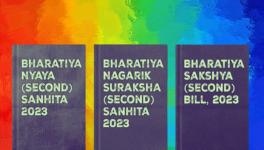BNSS: The New Penal Bracelet

Salman Rushdie in his celebrated novel, Midnight’s Children, wrote about Saleem. A fictional character born at the stroke of midnight when India was forging its post-colonial identity. Rushdie wrote, “mysteriously handcuffed to history; my destinies indissolubly chained to those of my country”.
Just as Saleem’s fate was intertwined with the upheaval of independent India, the changes in the criminal justice system toward alleged decolonisation have fettered the masses instead of setting them free. The insertion of a new provision under Section 43 (3), pertaining to handcuffing in Bhartiya Nagrik Suraksha Samhita (BNSS), 2023 has potential for abuse.
To begin with, there was no provision for handcuffing in the erstwhile Criminal Procedure Code, i.e., Section 46, relating to effectuate arrest. The judiciary had painstakingly put the reflection of the systematic bias to task since the act of handcuffing normalises the visual language of subjugation. The judiciary has condemned the practice of using ‘iron’ bespeaking of “barbarity hostile to our goal of human dignity and social justice”. Later, in the landmark judgement of Prem Shankar Shukla vs Delhi Administration, the court observed, “to inflict “irons” is to resort to zoological strategies repugnant to Article 21”.
While the tabling of Bills, Bhartiya Nagrik Suraksha Samhita (BNSS), Bhartiya Nyay Samhita (BNS) and Bhartiya Sakshya Adhiniyam (BSA), Parliament was heralded as a bold departure from the colonial justice system. The introduction of a provision to handcuff reveals itself otherwise. Rather than dismantling the colonial legacies in the criminal justice system, the provision reinforces the dehumanisation and preserves the colonial relics. With much of the existing framework in the criminal justice system left untouched,
A Brief History of Manacles
‘Time was invented by clock makers to sell clocks’, a quip often misattributed to the German philosopher Karl Marx. Though a hoax, the adage aptly emphasises how tools of control are shaped by the needs of their era. The 18th century was the age of capitalism, the epoch of the Industrial Revolution, which coincided with the waning of the slave trade and the era of capitalistic imperialism.
In 1780, the prototype of the modern-day handcuff emerged in Birmingham manufactured by Hiatt & Co, a leading manufacturer of handcuffs and dealing in slave collars aka negro collars. The equipment of restraint emerged not for peaceful administration but was mass-produced to dehumanise colonial subjects of the empire and enslaved individuals in the transatlantic trade.
The imperialistic state, through its institutions, legitimised the practice of handcuffing embedding it as a tool of social control. This act marked the “commodification of fiat”, turning instruments of oppression – objects never intended as natural commodities – into marketable goods. This created a cycle of exploitation and control through market mechanisms.
Even after centuries, this dark legacy surfaced when the connection between Hiatt & Co. and the infamous Guantanamo Bay detention camp came to light, sparking protests at the company’s historic site of production and reigniting debates over the commercialisation of oppression.
Alex R Nichols writes in his book, Handcuffs and Other Restraints: A Brief History and Survey, that the use of restraining instruments serves to make sure that the prisoners
are identified as such, to themselves and for all to see! One training manual describes handcuffing as a symbolic act and it is common in many countries for people to be automatically handcuffed on arrest, even in situations where escape is not a consideration. Another example is the recently reintroduced chain gang of the USA., where it seems that the function of the restraints is mainly to humiliate. That too was the major function of the pillory and stocks of olden times.
Faiz Ahmed Faiz a celebrated poet wrote letters to his beloved Alys during his term in prison for his alleged role in the Rawalpindi Conspiracy Case. In his act of defiance in one of the letters he had penned the iconic poem ‘Aaj Bazaar Mein Pa-Ba-Jolan Chalo’ (walk through the bazaar with shackles), the poem was against the indignity of Faiz being shackled and paraded to the dentist in a horse cart while onlookers recognised him as the ‘protest poet’. In his verses, he transforms that humiliation into resistance and wrote
We must walk these streets; bowed, confined
We must pass there in shackles and cuffs
With hands spread out; dancing in a daze
With bloodied garb and dust-caked hair
Through our beloved’s city, we must walk,
While everyone awaits us there.
Faiz chose to transform the oppressive imagery of shackles into a timeless symbol of resilience and dignity, immortalising defiance through his poetry. Yet, not everyone possesses the means to reclaim such humiliation, leaving many crushed beneath its weight.
The Parasites who may not be!
Recently, the Bar Association of Mannargudi has filed a petition i.e., (WP (C) 625/2024), in the apex court challenging the provisions of BNSS giving excessive power to the police. The contention raised against certain provisions of BNSS i.e., Section 43(3) (handcuffing), Section 107 (attachment, forfeiture of property), Section 223 (non-taking of cognizance of a complaint case without opportunity of hearing to accused) and Section 356 (trial in absence of accused).
While hearing the Petition before issuing notice, Justice Surya Kant observed that the provision under Section 43(3) of the BNSS relates to serious offenders, who are “kind of parasites in society” while upholding differential arrest for those who are alleged of committing the specific offences enlisted in Section 43 (3) of BNSS are
habitual, repeated offender who escaped from custody, who has committed the offence of organized crime, the offence of terrorist act, drug-related crime, or offence of illegal possession of arms and ammunition, murder, rape, acid attack, counterfeiting of coins and currency notes, human trafficking, sexual offences against children, offences against the state, including acts endangering sovereignty, unity and integrity of India or economic offences.
However, there are certain aspects to be considered beforehand; first, the Indian criminal justice system is premised upon the presumption of innocence. Innocent until proven guilty is often described as a “golden thread” running through the criminal justice system as the apex court puts it in a catena of precedents. The provision of handcuffing gives unbridled power to the police without any sanctions from the magistrate. Whereas the apex court in Citizens for Democracy vs State of Assam and Ors; has directed
Where the police or the jail authorities have well-grounded basis for drawing a strong inference that a particular prisoner is likely to jump jail or break out of the custody then the said prisoner be produced before the Magistrate concerned and a prayer for permission to handcuff the prisoner be made before the said Magistrate.
The introduction of the handcuffing clause without accompanying safeguards or guiding principles is a regressive step, particularly given that the judiciary’s directive on this issue was established nearly three decades ago. With technological advancements i.e., video conferencing, not producing the alleged criminal before being shackled and no provision to this effect raises queries on the lack of oversight on issues about human rights. The alternative to physical restraint, allowing the Magistrate to assess risks on a case-to-case basis and authorise manacling only when absolutely necessary, would have kept the ethos intact.
A similar petition challenging the provisions of the BNS and BNSS was filed in the apex court i.e., Azad Singh Kataria vs Union of India, WP (Crl.) No 461/2024. Justice Kant orally remarked that under US laws, people are handcuffed on the spot for even petty offences like traffic violations. This comparison overlooks the critical nuance that the practice in the US has been widely criticised as an excessive use of force and deemed beyond the bounds of objective reasonableness under the Fourth Amendment to the US Constitution. Drawing parallels from the vices of the American criminal justice system not only fails to justify similar measures but risks importing deeply flawed practices into the Indian criminal justice system.
Akin to several provisions introduced by tweaking the criminal justice system the provision under Section 43 (3) conflicts with the established judicial principles. A similar provision conflicting with the settled jurisprudence has been introduced i.e., Section 173 (3) BNSS, entrusting the police the power to conduct a preliminary inquiry before registration of an FIR. This was otherwise settled in Lalita Kumari vs State of U.P & Ors, that upon receiving information of a cognizable offence the police must register an FIR.
Furthermore, the ambiguity surrounding the term “habitual” in Section 129 of BNSS erstwhile in Section 110 of CrPC, can potentially set a stage for rampant misuse, disproportionately targeting marginalised communities. The open and broad interpretation allows the authorities to brand individuals as repeat offenders based on accusation rather than conviction. Procedure falling outside the ambit of criminal trials, procedural safeguards like mandatory legal representation are often ignored. The Punjab and Haryana High Court in Sukhdev Singh Dhindsa vs. State of Punjab had observed:
After the enactment of the 1973 Code, there is no offence which is triable by an Executive Magistrate. The only power given to the Executive Magistrate is to try the cases referred to in Chapters VIII and X of the Code. It may be interesting to note that the Law Commission in its report even did not favour the trial of cases falling under Section 110 of the Code of Criminal Procedure.
Additionally, the newly included Section 113 (terrorist act) of BNS (Bhartiya Nyay Samhita) has also been included in the provision for handcuffing. The provision is borrowed from certain provisions of the Unlawful Activities Prevention Act (UAPA).
The Special Rapporteur in 2021, had flagged the broad interpretation of ‘terrorist act’ as being inconsistent with the international standard of counter-terrorism. However, indeed, even the international community do not have a clear definition of terrorism. K.G Kannabiran had rightly pointed out in his memoir, Sisyphean Life in Law,
If an attack on a political or cultural organization is construed as a terrorist offence, every political conflict will be labelled a terrorist activity, and all political activity will be labelled ‘terrorism’.
The blanket insertion of handcuffing provisions threatens to normalise a practice that erodes human dignity and disregards the judicial mandate. This development must be seen in the broader context of the increasing concentration of power in police post the changes in the criminal justice system. It is commonly stated that the nature of police activities provides an important clue to the character of a political regime. By empowering the police with unchecked authority, the provision risks being weaponised to stifle dissent, with handcuffing emerging as another tool of humiliation.
Perhaps, handcuffing, at best, would be a cosmetic upgrade in the treatment of alleged criminals in many states, where alleged criminals are paraded with a rope tied around their waist. They would now be fettered with the government’s penal bracelet in accordance with the new provision of the procedural code.
The writer is a legal practitioner based in Delhi. The views are personal.
Get the latest reports & analysis with people's perspective on Protests, movements & deep analytical videos, discussions of the current affairs in your Telegram app. Subscribe to NewsClick's Telegram channel & get Real-Time updates on stories, as they get published on our website.






















